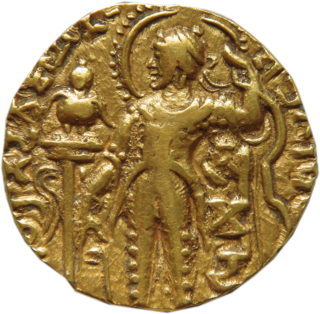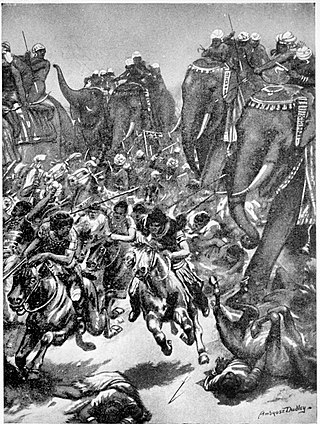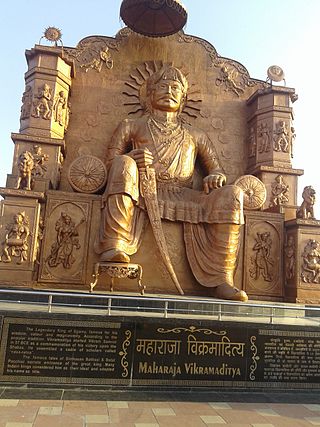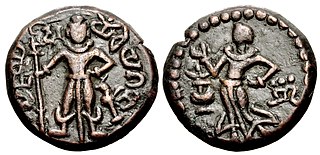The Gupta Empire was an ancient Indian empire on the Indian subcontinent which existed from the early 4th century CE to early 6th century CE. At its zenith, from approximately 319 to 467 CE, it covered much of the Indian subcontinent. This period has been considered as the Golden Age of India by historians, although this characterisation has been disputed by some other historians. The ruling dynasty of the empire was founded by Gupta and the most notable rulers of the dynasty were Chandragupta I, Samudragupta, Chandragupta II, Kumaragupta I and Skandagupta. The 4th-century CE Sanskrit poet Kalidasa credits the Guptas with having conquered about twenty-one kingdoms, both in and outside India, including the kingdoms of Persians, the Hunas, the Kambojas, tribes located in the west and east Oxus valleys, the Kinnaras, Kiratas, and others.

Chandragupta II, also known by his title Vikramaditya, as well as Chandragupta Vikramaditya, was the third ruler of the Gupta Empire in India. Modern scholars generally identify him with King Chandra of the Delhi iron pillar inscription.

Chandragupta I was a king of the Gupta Empire, who ruled in northern and central India. His title Mahārājadhirāja suggests that he was the first emperor of the dynasty. It is not certain how he turned his small ancestral kingdom into an empire, although a widely accepted theory among modern historians is that his marriage to the Licchavi princess Kumaradevi helped him extend his political power. Their son Samudragupta further expanded the Gupta empire.

Samudragupta (Gupta script: Sa-mu-dra-gu-pta, was the second emperor of the Gupta Empire of ancient India, and is regarded among the greatest rulers of India. As a son of the Gupta emperor Chandragupta I and the Licchavi princess Kumaradevi, he greatly expanded his dynasty's political and military power.

Ramagupta, according to the Sanskrit play Devichandraguptam, was an emperor of the Gupta dynasty of northern India. The surviving fragments of the play, combined with other literary evidence, suggest that he agreed to surrender his wife Dhruvadevi to a Shaka enemy: However, his brother Chandragupta II killed the Shaka enemy, and later dethroned him, marrying Dhruvadevi.

Skandagupta was a Gupta Emperor of India. His Bhitari pillar inscription suggests that he restored the Gupta power by defeating his enemies, who may have been rebels or foreign invaders. He repulsed an invasion by the Indo-Hephthalites, probably the Kidarites. He seems to have maintained control of his inherited territory, and is generally considered the last of the great Gupta Emperors. The Gupta genealogy after him is unclear, but he was most probably succeeded by Purugupta, who appears to have been his younger half-brother.

Yashodharman was a ruler of Malwa, in Central India, during the early part of the 6th century. He probably belonged to the Second Aulikara dynasty. He conquered much of the Indian subcontinent between c. 530-540 AD according to Mandsaur pillar inscription.

The Vakataka dynasty was an ancient Indian dynasty that originated from the Deccan in the mid-3rd century CE. Their state is believed to have extended from the southern edges of Malwa and Gujarat in the north to the Tungabhadra River in the south as well as from the Arabian Sea in the west to the edges of Chhattisgarh in the east. They were the most important successors of the Satavahanas in the Deccan and contemporaneous with the Guptas in northern India.

Vikramaditya was a legendary king mentioned in ancient Indian literature, featuring in traditional stories including those in Vetala Panchavimshati and Singhasan Battisi. Many describe him as ruler with his capital at Ujjain. "Vikramaditya" was also a common title adopted by several monarchs in ancient and medieval India, and the Vikramaditya legends may be embellished accounts of different kings. According to popular tradition, Vikramaditya began the Vikrama Samvat era in 57 BCE after defeating the Shakas, and those who believe that he is based on a historical figure place him around the first century BCE. However, this era is identified as "Vikrama Samvat" after the ninth century CE.

Yaudheya (Brahmi script: 𑀬𑁅𑀥𑁂𑀬) or Yoddheya Gana (Yoddheya Republic) was an ancient militant gana (confederation) based in the Eastern region of the Sapta Sindhu. The word Yaudheya is a derivative of the word from yodha meaning warriors and according to Pāṇini, the suffix '-ya', was significant of warrior tribes, which is supported by their resistance to invading empires such as the Kushan Empire and the Indo-Scythians. Rudradaman I of the Western Satraps notes in his Junagadh rock inscription that the Yaudheyas were 'heroes among all Kshatriya' and 'were loath to surrender'. They were noted as having a republic form of government, unique from other Janapadas which instead maintained monarchies.

Ghatotkacha was a pre-imperial Gupta king of northern India. He was a son of the dynasty's founder Gupta, and the father of the dynasty's first emperor Chandragupta I.

The Sacred Rocks of Hunza or Haldeikish constitute one of the earliest sites of Petroglyphs along the ancient Silk Route. It is a cultural heritage site in Gilgit-Baltistan region of northern Pakistan. The carvings on the rocks dates back to the 1st Millennium AD.

The iron pillar of Delhi is a structure 7.21 metres high with a 41-centimetre (16 in) diameter that was constructed by Chandragupta II, and now stands in the Qutub complex at Mehrauli in Delhi, India. The metals used in its construction have a rust-resistant composition. The pillar weighs more than six tonnes and is thought to have been erected elsewhere, perhaps outside the Udayagiri Caves, and moved to its present location by Anangpal Tomar in the 11th century.

Sridharavarman was a Saka (Indo-Scythian) ruler of Central India, around the areas of Vidisa, Sanchi and Eran in the 4th century CE, just before the Gupta Empire expansion in these areas. He calls himself a general and "righteous conqueror" in an inscription, and Rajan ('King') and Mahaksatrapa in a probably later inscription at Eran, suggesting that he may have been a high-ranked officer who later rose to the rank of a King.
The Second Aulikara dynasty was a royal dynasty that ruled over the Malwa plateau, and at its peak under Yashodharman Vishnuvardhana controlled a vast area, consisting of almost all of Northern India and parts of Deccan plateau. It was the second royal house of the Aulikara clan.

The Battle of Sondani was a large military encounter fought in 528 CE, between the Alchon Hun emperor Mihirakula and a confederation of Indian rulers led by king Yashodharman of Malwa.
Bhageerath was a king of the Kadamba dynasty in South India. He succeeded his father Kangavarma on the Kadamba throne.

The Gupta conquests of Bengal began with Samudragupta's initial conquest of Bengal, defeating its kings and gaining a large part of that region. Other kings then surrendered to the King of the Gupta Empire. Chandragupta II later defeated the rebel confederacy of Bengal and re-conquered the area, adding it to the Gupta Empire.

The Gupta-Saka Wars refers to the military conflict between the Gupta Empire, ruled by Chandragupta II, and the Western shatrapas, also known as the Shakas, during the 4th century CE.
The emergence of the Great Kushans in Bactria and Northwestern India during the first century A.D. reshaped the geopolitical landscape of the region, impacting trade routes, international politics, and regional power dynamics. Economically, the Kushans served as intermediaries in trade, controlling crucial sections of the Silk Road and redirecting trade between China, India, and the eastern countries away from Parthian territory. This posed a significant economic challenge to the Parthians and positioned the Kushans as major players in international trade. Politically, the rise of the Kushans had profound implications for Iran, as it found itself sandwiched between the Roman Empire and the Kushans. The Romans recognized the strategic importance of the Kushan Empire and sought direct relations with its rulers to safeguard trade routes between Rome, China, and India. This geopolitical scenario led the early Sasanians to prioritize the conquest of the Kushan empire in their Eastern policy, eventually achieving remarkable success under Emperor Ardashir I. Following the decline of the Great Kushans, remnants known as the "Little Kushans" persisted in the Punjab region, eventually being subjugated by the Gupta Empire under Samudragupta. His inscription on the Allahabad pillar illustrates Gupta dominance over the last Kushan rulers, who were forced to accept Gupta suzerainty. Samudragupta's strategic alliances and military campaigns against the Sassanians and other regional powers solidified Gupta control over large parts of the Indian subcontinent. However, the Gupta Empire faced various challenges, including incursions by the Hunas, who posed a considerable threat to neighboring civilizations. Skandagupta's leadership and military strategy were crucial in resisting Huna advances, although the extent of damage caused by their invasions remains debated among scholars. Despite facing external pressures, internal succession issues within the Gupta dynasty, such as the question of rightful heirs, also contributed to the complexities of governance during that time.












